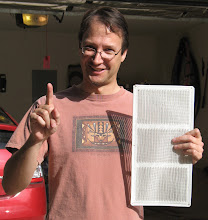In my last post, I described some reasons why doing the work I'd done through 2007 was worth it. But I am aware that many readers want to know how different efficiency measures pay off from a purely financial point of view. This is certainly a reasonable question, although I would disagree that it is the only meaningful arena of consideration.
But to help answer the financial question, I will consider my first three improvements as a unit, since I performed them in a roughly overlapping span of time. Here are the numbers, as best my records have them:
Data:
Approximate capital cost of improvements: $1150.00
Approximate average reduction in monthly bills: $50.00
Calculations:
Payoff time: $1150 / ($50/month) = 23 months = about 2 years
Effective interest rate: (100% / 2) = about 50%
For comparison, the effective interest rate for a good bank account is maybe 6% these days. So, interested readers, peruse the following statement and marvel: my investment in energy efficiency is earning me over 8 times the effective rate of a savings or bank account.
One caveat in this is that I have discounted my own labor rate. For 2 of my 3 improvements, I paid for someone else's labor, so the calculation is correct. For the other improvement, I used my own (unpaid) labor to remove the old insulation blocking my soffits. This labor cost should ideally be included, which would reduce my effective interest rate. However, I did not track my hours of time on this. I would highly doubt that it would lower my interest rate to anywhere near the going bank rate.
One lesson from all this is that if you do these improvements yourself (i.e. you have more time than you do money to spend on energy efficiency), then you can reap incredible financial returns on your investment. In my case, over 50% of the money I spent was on paying for someone else's labor, not on materials. Had I done this work myself, spending more quality time in the attic, I would have more than doubled my effective interest rate, paying off the materials used (a ridge vent and baffles) in a single year.
One thing a lot of folks seem to assume is that after the payoff period (about 2 years for me), the improvements are "done" - that is, they are no longer making you money. This is the exact opposite of the truth. Every single month, from here until I sell my home, my investments in energy efficiency will keep my bank account $50.00 higher, which is the same as if I had a nice fat checking account sending me that amount in interest. In fact, these improvements give me the added benefit of "energy price insurance": should the cost of energy continue to rise, as it has in the recent past, the value of my investment goes up. My $50/month savings will be come $100/month savings if the cost of energy doubles.
So, according to my calculations, if you have any money to invest, investing it in your own energy efficiency makes a incredible amount of sense. "Should I put that $1000 in a savings account at 6% or into my attic at 50%?" For most of us, this question answers itself.
And not to put too fine a point on it, but I've still got another 2 years of improvements to tell you about. Be patient, energy efficiency enthusiasts, and read on!
Sunday, September 20, 2009
Subscribe to:
Post Comments (Atom)


No comments:
Post a Comment